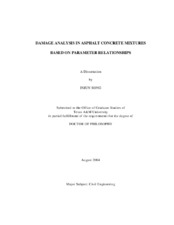| dc.description.abstract | Asphalt pavements experience damage due to traffic loading under various environmental conditions. Damage can be caused by viscopl
microcracks, fracture due to fatigue cracking, or fracture due to thermal cracking. Asphalt pavements have the capability to remedi
s damage depending on binder surface and rheological properties, filler surface properties, and length of rest periods.
Asphalt mastic (asphalt and fine aggregates) properties play an important role in controlling damage and healing. This dissertation
development of a comprehensive methodology to characterize damage and healing in asphalt mastics and mixtures. The methodology reli
ctive imaging techniques (X-ray CT), principles of continuum damage mechanics, and principles of micromechanics. The X-ray CT yield
meter that quantifies the percentage of cracks and air voids in a specimen. The continuum damage model parameters are derived from
p between applied stress and pseudo strain. The micromechanics model relates the damaged mastic modulus to a reference undamaged mo
ationship is a function of internal structure properties (void size, film thickness, and percentage of voids), binder modulus, aggr
and bond energy between binder and aggregates. The internal structure parameters are all obtained using X-ray CT and correlated.
The developed methodology was used to characterize damage in asphalt mastic and mixture specimens tested using the Dynamic Mechanic
A) and dynamic creep test. The damage parameter measured using X-ray CT correlated very well with the predictions of the continuum
ics models. All damage parameters were able to reflect the accumulation of damage under cyclic loading and were also able to captur
of moisture conditioning on damage. Although this dissertation focused on fatigue cracking at room temperatures, the methodology d
used to assess damage due to different mechanisms such as permanent deformation and low temperature cracking. | en |


